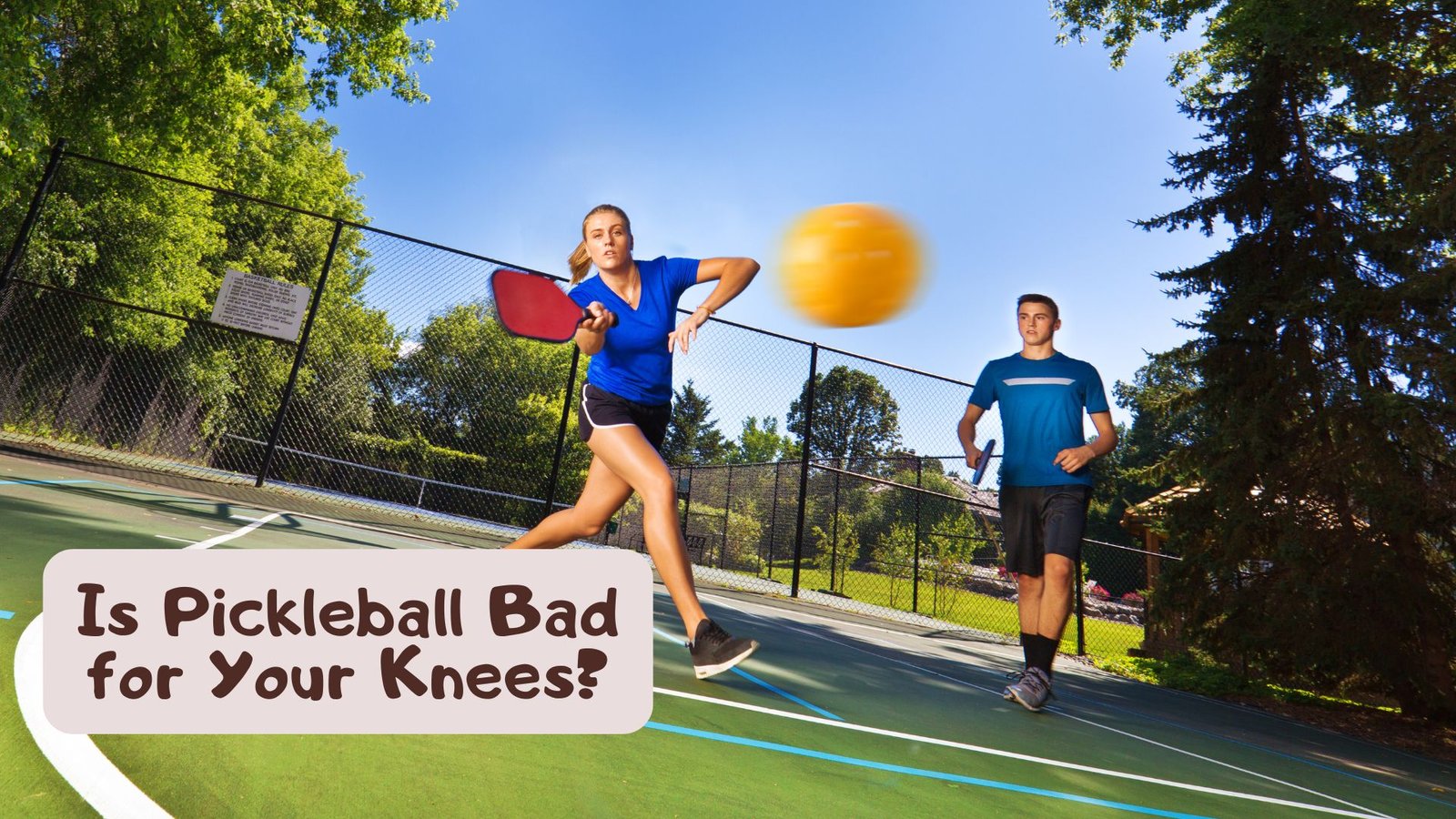Pickleballlane is reader-supported. If you click a link on this page and make a purchase, we may receive a small commission at no extra cost to you.
Article Content
Pickleball, a sport that blends elements of tennis, badminton, and table tennis, has surged in popularity, attracting nearly 14 million players in the United States in 2023, according to USA Pickleball.
Its accessibility and social appeal make it particularly popular among older adults, with 52% of active players aged 55 or older.
QUICK ANSWER
Pickleball is not inherently bad for your knees, but its quick lateral movements, sudden stops, and crouching stance can stress joints, particularly for older players or those with pre-existing conditions like arthritis.
However, as pickleball courts multiply, so do questions about its impact on knee health.
This article explores whether pickleball is bad for your knees, delving into injury risks, contributing factors, and evidence-based strategies to protect your joints, drawing on medical research, expert opinions, and player experiences.
Understanding Pickleball and Its Physical Demands
Pickleball is played on a 20-by-44-foot court, roughly the size of a badminton court, using a solid paddle and a perforated plastic ball.
The game involves quick lateral movements, sudden stops, rapid changes in direction, and a characteristic crouching stance near the “kitchen” (the no-volley zone), which can stress the knees.
While pickleball is considered less demanding than tennis or racquetball due to its smaller court and slower pace, these movements can still challenge joint health, particularly for players unaccustomed to such activity or with pre-existing knee conditions.
The sport’s appeal lies in its inclusivity, allowing players of varying fitness levels to participate. However, this accessibility can lead to injuries if players, especially beginners or older adults, overestimate their physical readiness.
The Hospital for Special Surgery notes that while pickleball is relatively safe, its repetitive movements can take a toll on knees, particularly for those with arthritis or balance issues.
Knee Injuries Associated with Pickleball
Medical research and clinical observations confirm that knee injuries are a notable concern in pickleball, though not unique to the sport.
A study published in the National Library of Medicine highlights that knee injuries common in racket sports like tennis—such as sprains, meniscal tears, and ligamentous injuries—are likely to affect pickleball players.
Specific injuries include:
Sprains and Strains:
Rapid starting, stopping, or pivoting can strain ligaments (e.g., collateral ligaments) or muscles around the knee, causing pain, especially during lateral movements.
Meniscal Tears:
Twisting motions may tear the meniscus, the cartilage cushioning the knee, leading to swelling, reduced range of motion, or difficulty bearing weight.
Patellar Tendinitis:
Known as “jumper’s knee,” this involves inflammation of the patellar tendon due to repetitive stress from crouching or lunging.
Anterior Cruciate Ligament (ACL) Tears:
Though less common, sudden bursts or poor landings can tear the ACL, often accompanied by a popping sound and significant swelling.
Osteoarthritis Flare-Ups:
For players with pre-existing arthritis, repetitive movements can exacerbate joint pain or stiffness.
Injury statistics underscore these risks. The American Orthopaedic Society for Sports Medicine reports that 91% of pickleball injuries occur in players aged 50 or older, with lower extremity injuries, including knees, accounting for 29% of all injuries.
Knee-specific injuries, such as sprains (33%) and fractures (28%), are among the most frequent. A study cited by NBC News notes a dramatic rise in pickleball-related fractures, with 92% resulting from falls, though soft tissue injuries like knee sprains are even more prevalent.
The American Academy of Orthopaedic Surgeons reported a 90-fold increase in fractures among players in their 60s over the past five years, highlighting the physical demands on older players.
Risk Factors for Knee Injuries
Several factors increase the likelihood of knee injuries in pickleball:
Age and Joint Health:
Older players, particularly those over 50, face higher risks due to reduced muscle strength, joint flexibility, and balance. The AMA emphasizes that pre-existing arthritis or joint pain can flare up, especially without adequate rest.
Pre-existing Conditions:
Players with prior knee injuries, arthritis, or ligament issues are more susceptible.
Lack of Physical Conditioning:
Beginners or sedentary individuals transitioning to pickleball may lack the muscle strength or endurance needed for its demands, leading to overuse injuries.
Court Surface:
Hard surfaces like concrete, common in many pickleball courts, can increase joint impact compared to softer surfaces
Technique and Intensity:
Poor movement mechanics or overzealous play, such as lunging without proper footwork, can strain knees. The Florida Orthopaedic Institute highlights that players camping in a mid-court crouch are particularly vulnerable.
Comparing Pickleball to Other Sports
To contextualize pickleball’s impact on knees, it’s useful to compare it to other racket sports:
| Sport | Knee Impact | Key Factors |
|---|---|---|
| Pickleball | Moderate; quick lateral movements and crouching stress knees, but less running. | Smaller court, slower pace reduce intensity; risks from sudden stops and twists. |
| Tennis | High; extensive running and aggressive pivoting increase knee strain. | Larger court, faster pace, and harder serves amplify joint impact. |
| Badminton | High; rapid directional changes and jumping strain knees. | High-intensity lunging and small court increase knee stress. |
| **Racquetball Ascertainment | Moderate; less running but quick lateral movements. | Smaller court, underhand serve reduce shoulder strain; knee risks remain. |
Pickleball’s smaller court and slower pace make it less demanding than tennis or badminton, but its unique movements still pose risks.
The Hospital for Special Surgery notes that pickleball requires less running than tennis, but the squatting stance in the kitchen can pressure the kneecap, contributing to tendonitis.
Prevention Strategies for Knee Health
Experts agree that while pickleball can stress knees, proactive measures can significantly reduce injury risks. Here are evidence-based strategies:
Dynamic Warm-Ups:
Perform dynamic stretches before playing, such as walking lunges, high knees, mini squats, or calf raises, to prepare muscles and joints. The AMA recommends having “a few drops of sweat” to ensure readiness.
Post-game, use static stretches to maintain flexibility, targeting hamstrings, quadriceps, and calves.
Strengthening Exercises:
Strengthen muscles supporting the knees, including quadriceps, hamstrings, and calves, with exercises like squats, lunges, and calf raises. P3 Athletic emphasizes lower-body strength to enhance knee stability.
Core exercises, such as planks or Pilates, improve overall balance, reducing knee strain.
Proper Footwear:
Wear court-specific shoes with lateral support and cushioning, such as tennis shoes with firm outsoles. Florida Orthopaedic Institute notes that proper footwear reduces injury risk during sudden movements.
Technique and Footwork:
Learn proper movement mechanics to minimize knee stress. Consider coaching to improve footwork and shot execution.
Gradual Progression:
Ease into pickleball, especially if new to the sport or returning after inactivity. Gradually increase play intensity and duration to allow joint adaptation.
Court Surface Consideration:
Where possible, play on cushioned or softer surfaces to reduce joint impact. If playing on concrete, ensure it’s coated with acrylic or polyurethane for better shock absorption.
Listen to Your Body:
Avoid pushing through pain, particularly for older players with arthritis. The AMA advises resting during pain flare-ups to prevent worsening.
Managing Knee Pain and Injuries
If knee pain occurs, prompt action can prevent further damage:
RICE Method:
For acute injuries, use Rest, Ice, Compression, and Elevation to reduce swelling and pain. Apply ice for 15-20 minutes and elevate the knee.
Pain Management:
Mild pain may respond to over-the-counter medications like Tylenol or Motrin. Persistent pain requires medical evaluation.
Physical Therapy:
A therapist can design a program to strengthen knees and restore mobility, as supported by P3 Athletic.
Medical Evaluation:
Seek immediate care for symptoms like significant swelling, inability to bear weight, or knee instability, which may indicate serious injuries like meniscal tears or ACL damage. The National Library of Medicine recommends physician evaluation for such symptoms.
Post-Surgery Considerations:
Players with surgically repaired knees can return to pickleball with caution, starting with low-intensity play and medical clearance.
Addressing the Evidence Gap
While pickleball’s injury risks are well-documented, specific studies comparing knee injury rates to other sports are limited.
The National Library of Medicine draws parallels with tennis, suggesting similar injury patterns, but pickleball’s underhand serve may reduce upper-body strain, potentially shifting stress to the knees.
The lack of longitudinal data means reliance on expert consensus and anecdotal evidence, which consistently emphasize preparation and conditioning to mitigate risks.
Player experiences, shared on platforms like Reddit, highlight discomfort on hard surfaces or with prolonged play, but many report reduced pain with proper shoes and warm-ups. These insights align with medical advice, reinforcing the importance of proactive measures.
Conclusion
Pickleball is not inherently bad for your knees, but its quick lateral movements, sudden stops, and crouching stance can stress joints, particularly for older players or those with pre-existing conditions like arthritis.
Injury statistics, such as the 29% of pickleball injuries affecting lower extremities, underscore the need for caution.
However, with proper preparation—dynamic warm-ups, strengthening exercises, supportive footwear, and gradual progression—players can significantly reduce risks.
Compared to tennis or badminton, pickleball’s smaller court and slower pace make it less demanding, but it still requires respect for physical limits.
By listening to their bodies and seeking timely medical advice, players can enjoy pickleball’s physical and social benefits while safeguarding their knee health.
As the sport continues to grow, investing in proper conditioning and court maintenance will ensure it remains a safe and enjoyable activity for all.
Also Read:

